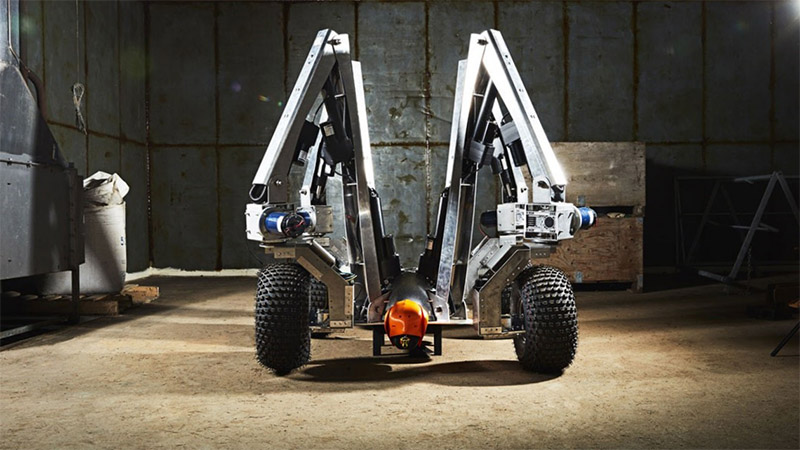Drones are saving the rainforest
More than half of the world's rainforests have already been lost to mankind's need for wood and farmland. The rainforests, which once accounted for more than 14 percent of the earth's surface, now only cover about 6 percent of our planet.
If the present deforestation and forest fires continue, within the next hundred years these critical habitats could disappear completely. Drones that drop new tree seedlings are a potential salvation.

©Dan Bun-Forti, WIRED
The first time that Win Maung, head of the mangrove restoration project at the Worldview International Foundation (WIF), a Norwegian nonprofit organization, came to this part of the Ayeyarwady coast in Myanmar was in the 1990s. The area was densely forested then. "The trees were so big that I couldn’t get my arms around them. Now," he says, pointing to the scrawny plants, "there is hardly a tree anywhere with a trunk whose diameter is more than ten centimeters."
In the past, mangrove forests stretched almost completely around the Bay of Bengal, in an arc from Bangladesh in the north to Thailand in the south, forming a natural line of defense against typhoons that hit the coast every few years. In the last few decades, the forests have been cut down bit by bit to produce charcoal or make room for shrimp farms, rice paddies, and hotels. In Myanmar alone, one million hectares of mangroves have disappeared since 1980.
For the past four monsoon seasons, Win Maung has overseen the attempt to rebuild the forest barrier. It's a dirty, difficult, and tedious job. Employees from local communities plant seedlings by hand, squatting for hours in the mud. Since 2015, they have planted five million trees, now covering more than 2,000 hectares of land. The whole undertaking is tedious and exhausting in the extreme. This is why a more radical solution has been undergoing testing here over the past 18 months: Drones from the Oxfordshire-based startup BioCarbon Engineering have been flying missions over the destroyed mangroves.
Trees out of the air
White quadrocopters, one meter in diameter, climb skyward to create high-resolution SK.AI maps of the terrain. The data is subjected to an algorithm that analyzes the topology, slope, soil type, and humidity, all factors that will be used to determine the optimal position for each individual seed. The drones also gather detailed information about the seedlings as they grow.
Another fleet of UAVs then fly two meters above the ground and shoot a compressed air salvo into the mud, leaving a rippled line on the ground. With each shot, a white, marble-sized seed coat is fired, which penetrates a few centimeters below the surface. According to BioCarbon co-founder Irina Fedorenko, these drones, flying in six autonomous swarms, could plant 400,000 trees a day. "Of course, WIF had high hopes that we would plant one million trees in no time at all," says Fedorenko. "We did our best to find the best time to deploy. But then the rains we need didn’t come, or the high tide carried the seeds away. It is scary that there isn’t any normal weather any more. We can’t count on things to work normally, like they used to."
Two brave women fighting for the forest
With their project to restore ecosystems in Myanmar, of Win Maung and Fedorenko were already very successful. However, when measured against the global mass destruction of tropical forests, progress is far too slow – in 2017 alone, for example, almost 16 million hectares of tropical forests were destroyed.
Fedorenko, an environmental activist from Vladivostok, started working on forestry projects in the Russian Far East as a teenager. During her university studies, she founded Green Light, an NGO financially supported by the WWF and recognized by the United Nations.
In 2014, she participated in a meeting organized by the "Skoll Center for Social Entrepreneurship" in Oxford, where she presented an idea for a crowdfunding and monitoring platform for forestry. There she met Lauren Fletcher, who had worked as an engineer at NASA for 20 years and was working on a project to research life forms on Mars.
Fedorenko and Fletcher spent the next six months introducing Fletcher's idea at competitions and to potential investors. Their first success came in February 2015, when their concept was selected as a finalist in "Drones for Good," a competition organized by the Emirate of Dubai offering USD 1 million in prize money.
"At the time we didn’t even have a drone," says Fedorenko. With a small grant from the Skoll Foundation and some money provided by the competition itself, they hired their first employee, an engineer, and cobbled together a prototype. This held its own against teams put forward by global technology companies, taking third place. "That's how it all started," says Fedorenko. “And that’s when we thought: Now our dream is becoming a reality.”
A few months later, the prototype won the top prize of 100,000 euros at the "Hello Tomorrow" conference in Paris. Executives from the French drone manufacturer Parrot were in the audience and told Fedorenko that they wanted to invest in the company.
"That was our first million. We may still have been working in a garage for the first two years, but at least it was a rented garage, not my mother's.”
Read the full article here.
About Peter Guest
Peter Guest is a writer at WIRED, UK
Our great sense of curiosity at Vontobel means we are attentively following scientific research in many key areas. This helps us recognize new investment opportunities early on. That’s why our thematic portfolios and thematic investments also reflect megatrends such as digitization, as we consider companies that are making valuable contributions to solving global challenges.
I am interested in thematic investments
I am interested in thematic funds
Who are we? How do we live today? And how will digitization change our lives? How the future will unfold is preoccupying society more than ever, with engineers, doctors, politicians – each one of us, in fact – seeking answers. This report on the reforestation of the rainforest is one of many contributions that shed light on the theme “Digitized Society” from a new, inspiring perspective. We are publishing them here as part of our series “Impact”.








